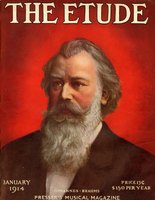MUSICAL THOUGHT AND ACTION ABROAD.
BY ARTHUR ELSON
IMPRESSIONISM IN MUSIC.
IN Die Musik Walter Niemann has written on the impressionism of Debussy and his contemporaries, while in the same number Hans Pfeilschmidt treated the subject of repetition and recognition of themes. The two articles thus approach from opposite ends the question whether form or freedom is more important in music.
In the best music form is still predominant. In fact, it would be quite difficult to write anything that had no shape, even if its form were not one of those existing in classical times. In the symphonic poem, which is the best example of modern freedom, there is still to be found a very marked form, though it may differ in individual cases. We find here sections rather than movements—sections which obey the laws of contrast, or follow the lines of some more or less definite subject. Even in such free works as “Zarathustra” or “Ein Heldenleben” there is some repetition of themes from one part to later portions, while individual sections show much of the building-up from themes that constitutes figure treatment and development. In such a work as Liszt’s “Les Preludes” there are returns of theme almost as definite as those of the symphony or sonata, and figures that pervade the entire work. It is a mistake, therefore, to assume that the modern school has abolished form. We might rather say that it has discarded forms. The tonal architect of to-day is not compelled to build his structure in certain limited ways, but may work along original lines. He should, however, make these lines fairly definite.
The impressionism of to-day, originating with Debussy, Satie, Fanelli, and others of the sort, is not now confined to France. Holbrooke, Bantock, Delius and Cyril Scott have adopted its methods in England; Scriabine leads the movement in Russia; Busoni is a modernist of Italian origin; while the chaotic Schoenberg has become the musical “bad boy” of Germany.
As is well known, the keynote of this school is novelty of harmonic effects. Perhaps “keynote” is hardly the right word, since few of these men keep definite tonalities, and some of them even discard signatures. This field of work is somewhat extensive. Debussy makes a scale of whole tones, corresponding to the higher overtones; Scriabine builds chords on the repeated interval of a fourth; while others have no definite system, but indulge constantly in the novelty of the unexpected. With these new harmonies comes also a new method of treatment—an avoidance of harmonic progressions, and a use, instead, of detached effects that have been aptly termed “musical stippling.”
In some ways the modernists have won a great artistic success. Thus the piano pieces of a Debussy or a Scott show the most delicate nuances, and are of rare value in their pictorial qualities. But in the orchestral field the school is apt to show too much emphasis on the search for effects, and too little attempt at any real outlines of form. The very principle of detachment in effects is one that militates against form, and deprives it of its proper importance. Admitting that the modernists have enlarged our range of harmony, we still need orchestral composers who shall use these effects as a means rather than an end. Dabbling experimental colors on a palette, for instance, is not the same thing as using them to paint a great picture. Thus a number of recent compositions must be classed as experiments rather than true works of art. They may lead to the growth of a great school, but they do not entirely constitute such a school at present. The involved “Afternoon of a Faun,” for example, is not so generally popular in our concerts as the symphonies or symphonic poems of our own Gustav Strube, which make use of Debussy’s harmonic style, but fuse it into a work of broader outlines and larger form. When the experimentalists grow to recognize more fully the value of musical architecture they will create a school of permanent worth.



